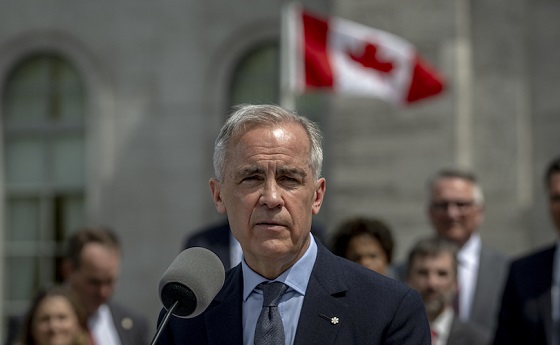Uncategorized
The Biden-Harris Version of Trump’s ‘Cruel’ Mass Deportation of Immigrant Families – with No Media Freakout

ICE forces immigrant families to board a deportation flight in McAllen, Texas. November 2021 photo by Todd Bensman
From The Center for Immigration Studies
By Todd Bensman
The profound hypocrisy of the outrage machine now ginning up against Trump’s coming deportation machine
Democratic Party oppositionists, immigrant advocates, and their U.S. media allies are mobilized and dug in with sharpened staves for all-out political war against one of President-elect Donald Trump’s signature plans: “the greatest mass deportation in American history,” as he has put it.
In harbingers of the kind of framing to come, opponents of immigration law are choosing metaphoric language harkening to the Nazi holocaust machine and the Bosnian civil war.
“Immigration Lawyers Prepare to Battle Trump in Court Again,” reads one typical recent New York Times headline over a story calling the Trump plans “harsh” and describing how battalions of immigration lawyers and civil liberties groups are mobilizing to wage total legal and political war to stop them.
“We literally have a blueprint of what they are planning to do, and so we had months and months to figure out how to protect people,” the paper quoted Becca Heller, founder of the International Refugee Assistance Project, saying. “Trump has told us what to expect – hate and persecution and concentration camps.”
“Ethnic cleansing,” Los Angeles Times reporter Ronald Brownstein called the plan in an X post when Tom Homan, the former head of U.S. Immigration and Customs Enforcement just appointed to spearhead the initiative, told a visibly offended 60 Minutes interviewer that whole families will be deported together to avoid “family separation.”
The liberal Mother Jones magazine expressed outrage, falsely claiming that Homan said U.S. citizen children would be deported. The New Republic screamed that the mass deportation policy proposal confirmed that real action would back every “hateful word spewed” at Trump’s “fascist” rallies.
But in his 60 Minutes interview, one of Homan’s potentially most illuminating comments went unexplored.
“We’ve done it before,” Homan told the interviewer about deporting families together in large numbers.
In that, Homan was exactly right. It wasn’t, however, Donald Trump or Homan who did it but the Biden-Harris administration, secretively and never covered by major media and continuing to this day.
In 2021 and 2022, the Biden-Harris administration launched an ICE air operation that has mass-deported by air as many as 550,000 often Central American immigrants to date – keeping together whole families that included babes in mother’s arms. I know this because I remain perhaps the only American writer who witnessed, videotaped, and reported the massive airlift while it happened at unmarked hangers by plain-clothed ICE agents driving unmarked vehicles putting them onto unmarked ICE-contracted jets in small, out-of-the-way U.S. airports.
I wrote video and print dispatches for the Center for Immigration Studies website and dedicated most of an entire chapter to the operation in my 2023 book, OVERRUN: How Joe Biden Unleashed the Greatest Border Crisis in U.S. History.
While these are considerably smaller than what the incoming Trump administration envisions, recounting these 2021-present Biden-Harris operations today serves two important purposes in the new context of a second Trump presidency and the coming all-out information war offensive against it in the coming year.
For starters, the fact that Biden-Harris carried out family deportation flights spotlights the profound dual-standard hypocrisy of today’s emerging crop of political warfighters and their media supporters because Donald Trump is doing it rather than the president they liked and wanted to politically protect.
Secondly, the Biden-Harris mass deportation airlift, although it is probably smaller in scale than what’s coming, provides an important value for the next administration – as a sound operational blueprint for those in the Trump administration who will carry it out.
The Biden-Harris mass deportation airlift for immigrant families begins
The Biden-Harris mass family deportation program was born of an internal White House conflict (well reported by the New York Times, Washington Post, and Wall Street Journal) between progressives who’d engineered the historic mass migration over the southern border that began on Inauguration Day 2021 and more pragmatic administration figures who only a few months later were greatly fearing heavy political losses for Democrats at the November 2022 mid-term elections. Among the latter were, for instance, White House chief of staff Ron Klain, national security adviser Jake Sullivan, and Domestic Policy Council Adviser Susan Rice among others, as I reported in detail in OVERRUN’s Chapter 15, titled “White House Rebellion.”
Initially, the White House pragmatists won permission from Biden himself to start the flights in August 2021, one month after a record-setting 213,000 July border apprehensions generated negative international headlines and, notably, low polling numbers for Democrats as a 2022 mid-term election issue. They felt like they had to drive the numbers down through the potent deterrence that removal flights provide.
At the time, the pandemic-era “Title 42” instant pushback policy was still technically in place, although the progressives on Inauguration Day had torn huge exemptions into it to let in families, unaccompanied minors, and extra-continentals from around the world, which had led to immediate historic crossing levels within two months.
The pragmatists decided to use Title 42 as the legal basis for these removal flights.
The Department of Homeland Security (DHS) did publicly announce “expedited removal” flights would commence for “certain families who recently arrived at the southern border … and do not have a legal basis to stay in the United States.” The DHS statement hinted obliquely that the aim of the flights was to persuade migrants from Central America, among the most populous of border crossers, to stay home on grounds that “irregular migration … is especially dangerous for families and children.”
At first, they targeted Guatemalan, Honduran, Salvadoran, and Venezuelan family groups because those nationalities were the most numerous crossers, although the flights sharply escalated after the catastrophic September 2021 Del Rio bridge crisis when 15,000 Haitians poured over the Rio Grande all at once and drew even more intensive international media attention. Haitians were added to the target list as were a half dozen other high-volume nationalities over time, such as Brazilians and Ecuadorians.
But starkly unlike what is happening now with Trump’s plan, there was little to no public outrage or information-war preparation over the Biden deportations, which require detentions of families ahead of the flights and are ongoing.
While some Initial media reports back in 2021 indicated the first Biden flights ran into delays, coverage of what happened next dried up entirely as those flights have sharply escalated and remain steady even now as illegal immigration advocates and their media support networks express only outrage at the coming Trump program.
I got onto the story four months after the Biden-Harris flights began, when the flights were escalating. Eventually, I was able to personally observe and report on ICE loading up planes with detained women and children at the McAllen, Texas, international airport. (See Don’t Look Now, but ICE is Deporting Some Central American Families by Air, December 1, 2021, Center for Immigration Studies.)
The monthly flights soon doubled, and then doubled again. I kept writing, but still, no one has much publicly complained, let alone gone to war over them.
Biden’s Blueprint for Trump
At first, the Biden-Harris jets flew many of the families directly to Guatemala and Honduras tarmacs.
But the Biden-Harris State Department got the Mexican government involved in a collaboration. The flights could land in the southern Mexican cities of Tapachula and Villahermosa. The Mexican government, in a barely reported September 2021 agreement with the Biden administration, would transport the arriving deportees by bus to Honduras and El Salvador.
The flights program didn’t go completely unnoticed by pro-immigration advocacy groups, which mainly complained privately to the administration and kept the newspapers out of it. An outraged anti-deportation group called Witness at the Border had been tracking what it termed “Death Flights” under Trump and issuing solid analyses for its side of the cause.
Witness at the Border’s Thomas Cartwright, a retired banking executive and migration advocate who tracks removal flights as a volunteer, noticed that progressively declining numbers of flights during opening months of the Biden administration suddenly skyrocketed from a mere 46 removal flights in July 2021 to a “stunning” 193 in September 2021, he reported.
Some of that increase was attributable to “the massive Haiti expulsion program” (to empty the Del Rio camp), Cartwright later told me in an interview, but also to a major new expansion of the flights to Guatemala and to Tapachula and Villahermosa in southern Mexico.
By the end of Biden’s first 12 months, the administration had sent off 1,931 removal flights using five charter carriers (IAero, World Atlantic, GlobalX, Eastern Air, and OMNI). The Biden flights had eclipsed Trump’s last year of flights by 116.
And the Biden-Harris administration aggressively expanded them as the mid-term elections approached. During 2022, the Biden-Harris DHS was sending flights to 16 other countries in Latin America, the Caribbean and even as far as Sierra Leone, Guinea, Liberia, Nigeria, India, and Vietnam.
The administration secretively renewed flights to Haiti long after the Del Rio camp debacle, too. (See: Biden Administration Secretively Renews Daily Air-Repatriation Flights to Haiti, CIS January 27, 2022).
By Spring of 2022, in fact, the Biden-Harris flights of one single year surpassed flights sent by Trump in all four of his years.
The Biden-Harris administration never advertised what it was doing nor released information about the flight numbers (and never responded to my requests for details and interviews.)
But assuming a conservative 100 deportees per flight (many planes had capacity for 135-150 passengers, they returned at the very least 195,000 women, children and single men by the end of that first year. The number, Cartwright told me in an interview, probably well exceeded 250,000.
In his most recent report, Cartright reports that the Biden-Harris administration has sent a total of 5,219 flights, including 1,598 in just the last 12 months.
Collectively, these amount to an estimated 575,000 immigrant air deportations since August 2021, including 175,000 just since January 2024.
There was plenty of evidence that the flights did suppress and deter targeted nationalities from coming so long as the flights continued. (See: Expanding Air Deportations Coincide with Falling Border Apprehensions, CIS February 22, 2022)
The Biden expulsion flights were “incontrovertible” evidence, Cartwright complained in a June 2022 monthly report on his group’s website, that the airlift was “a significant strategic imperative” of the Biden administration because they worked as “an impactful tool…to deter migration through the threat of immediate return.”
But clearly, the flights never reached a sufficient volume to deter the millions of migrants the administration still let in after illegal border crossings.
Presumably, this is why the incoming Trump administration sees a need to drastically increase the volumes.
The takeaway here is that the incoming administration can probably borrow parts of what the Biden-Harris administration built and expand the infrastructure and diplomatic arrangements with new receiving countries.
Double standards
Still, the absence of serious public opposition to any of the Biden-Harris program or mention of it by major media outlets currently airing criticism only of the proposed Trump program warrants consideration as fact in context not currently provided anywhere.
As the American public witnesses the wild fury of politicization over the Trump program, someone might think to ask Homan what, exactly, he meant when he told 60 Minutes that ICE already has long experience deporting immigrant families who entered the country and remain illegally.
Uncategorized
Trump Admin Establishing Council To Make Buildings Beautiful Again


From the Daily Caller News Foundation
By Jason Hopkins
The Trump administration is creating a first-of-its-kind task force aimed at ushering in a new “Golden Age” of beautiful infrastructure across the U.S.
The Department of Transportation (DOT) will announce the establishment of the Beautifying Transportation Infrastructure Council (BTIC) on Thursday, the Daily Caller News Foundation exclusively learned. The BTIC seeks to advise Transportation Secretary Sean Duffy on design and policy ideas for key infrastructure projects, including highways, bridges and transit hubs.
“What happened to our country’s proud tradition of building great, big, beautiful things?” Duffy said in a statement shared with the DCNF. “It’s time the design for America’s latest infrastructure projects reflects our nation’s strength, pride, and promise.”
“We’re engaging the best and brightest minds in architectural design and engineering to make beautiful structures that move you and bring about a new Golden Age of Transportation,” Duffy continued.
Mini scoop – here is the DOT’s rollout of its Beautifying Transportation Infrastructure Council, which will be tasked with making our buildings beautiful again. pic.twitter.com/
9iV2xSxdJM — Jason Hopkins (@jasonhopkinsdc) October 23, 2025
The DOT is encouraging nominations of the country’s best architects, urban planners, artists and others to serve on the council, according to the department. While ensuring that efficiency and safety remain a top priority, the BTIC will provide guidance on projects that “enhance” public areas and develop aesthetic performance metrics.
The new council aligns with an executive order signed by President Donald Trump in August 2025 regarding infrastructure. The “Making Federal Architecture Beautiful Again” order calls for federal public buildings in the country to “respect regional architectural heritage” and aims to prevent federal construction projects from using modernist and brutalist architecture styles, instead returning to a classical style.
“The Founders, in line with great societies before them, attached great importance to Federal civic architecture,” Trump’s order stated. “They wanted America’s public buildings to inspire the American people and encourage civic virtue.”
“President George Washington and Secretary of State Thomas Jefferson consciously modeled the most important buildings in Washington, D.C., on the classical architecture of ancient Athens and Rome,” the order continued. “Because of their proven ability to meet these requirements, classical and traditional architecture are preferred modes of architectural design.”
The DOT invested millions in major infrastructure projects since Trump’s return to the White House. Duffy announced in August a $43 million transformation initiative of the New York Penn Station in New York City and in September unveiledmajor progress in the rehabilitation and modernization of Washington Union Station in Washington, D.C.
The BTIC will comprise up to 11 members who will serve two-year terms, with the chance to be reappointed, according to the DOT. The task force will meet biannually. The deadline for nominations will end Nov. 21.
Uncategorized
New report warns WHO health rules erode Canada’s democracy and Charter rights

The Justice Centre for Constitutional Freedoms has released a new report titled Canada’s Surrender of Sovereignty: New WHO health regulations undermine Canadian democracy and Charter freedoms. Authored by Nigel Hannaford, a veteran journalist and researcher, the report warns that Canada’s acceptance of the World Health Organization’s (WHO) revised International Health Regulations (IHR) represents a serious erosion of national independence and democratic accountability.
The IHR amendments, which took effect on September 19, 2025, authorize the WHO Director-General to declare global “health emergencies” that could require Canada to follow directives from bureaucrats in Geneva, bypassing the House of Commons and the will of Canadian voters.
The WHO regards these regulations as “binding,” despite having no ability or legal authority to impose such regulations. Even so, Canada is opting to accept the regulations as binding.
By accepting the WHO’s revised IHR, the report explains, Canada has relinquished its own control over future health crises and instead has agreed to let the WHO determine when a “pandemic emergency” exists and what Canada must do to respond to it, after which Canada must report back to the WHO.
In fact, under these International Health Regulations, the WHO could demand countries like Canada impose stringent freedom-violating health policies, such as lockdowns, vaccine mandates, or travel restrictions without debate, evidence review, or public accountability, the report explains.
Once the WHO declares a “Pandemic Emergency,” member states are obligated to implement such emergency measures “without delay” for a minimum of three months.
Importantly, following these WHO directives would undermine government accountability as politicians may hide behind international “commitments” to justify their actions as “simply following international rules,” the report warns.
Canada should instead withdraw from the revised IHR, following the example of countries like Germany, Austria, Italy, Czech Republic, and the United States. The report recommends continued international cooperation without surrendering control over domestic health policies.
Constitutional lawyer Allison Pejovic said, “[b]y treating WHO edicts as binding, the federal government has effectively placed Canadian sovereignty on loan to an unelected international body.”
“Such directives, if enforced, would likely violate Canadians’ Charter rights and freedoms,” she added.
Mr. Hannaford agreed, saying, “Canada’s health policies must be made in Canada. No free and democratic nation should outsource its emergency powers to unelected bureaucrats in Geneva.”
The Justice Centre urges Canadians to contact their Members of Parliament and demand they support withdrawing from the revised IHR to restore Canadian sovereignty and reject blind compliance with WHO directives.
-

 Addictions2 days ago
Addictions2 days agoCanadian gov’t not stopping drug injection sites from being set up near schools, daycares
-

 Business2 days ago
Business2 days agoParliamentary Budget Officer begs Carney to cut back on spending
-

 Business2 days ago
Business2 days agoCarney government needs stronger ‘fiscal anchors’ and greater accountability
-

 Education2 days ago
Education2 days agoWhy classroom size isn’t the issue teacher unions think it is
-

 Fraser Institute2 days ago
Fraser Institute2 days agoCourts and governments caused B.C.’s property crisis—they’re not about to fix it
-

 Alberta2 days ago
Alberta2 days agoChatGPT may explain why gap between report card grades and standardized test scores is getting bigger
-

 Alberta1 day ago
Alberta1 day agoFederal budget: It’s not easy being green
-

 Energy20 hours ago
Energy20 hours agoIt should not take a crisis for Canada to develop the resources that make people and communities thrive.









